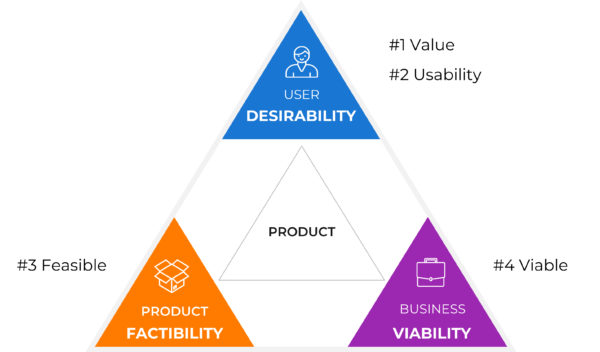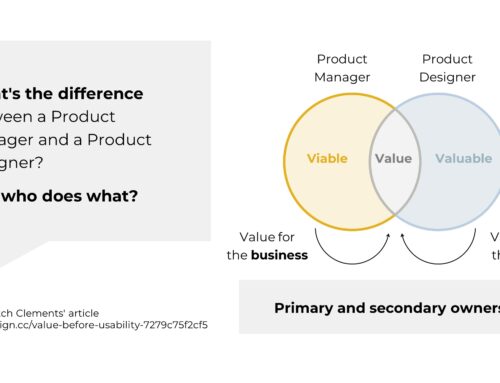When we develop a product or feature, it is important to consider the risks involved so we avoid investing time and resources in something that, at best, will need to be redone, or at worst, may not succeed.
On this topic, Marty Cagan discusses four product risks, which I categorize based on the product triad:
Value: Does the product address a genuine user need or solve a real problem? Is it something they would be willing to pay for or invest their time in? This directly impacts product adoption.
Usability: Can users easily navigate and interact with the product? Is the interface intuitive, and the features clear? A product with usability issues has little chance of adoption and retention.
Feasibility: Can we build it with the available technologies and resources, within an appropriate time frame and at an acceptable cost?
Viability: Will the product be profitable and sustainable? Will we be able to charge an adequate price for it? Is the business scalable? Are there potential barriers to entry? Challenges in adoption?
Users: 50% of the Risk
When we look closely, two of the four risks (that is half!) relate to the user. Yet user-related risks are often the least validated. Why?
To begin with, technology and business risks are much “easier” to “validate” (*):
- Business risks can be “figured out” quickly by running numbers in spreadsheets until the plan makes sense. Pricing is validated quickly based on the competition.
- Technical risks are also “easily” identified through size estimates (S, M, L), dot voting, or the Fibonacci scale.
(*) I say “easier” because, although the process isn’t easy, it is often oversimplified to an extreme with spreadsheets or “group think” tools. I also say “validate” because usually “validation” processes are approached more with the intention of “proving” the feasibility of an idea than with a genuine interest in “discovery.”
Value is not validated because:
- It’s taken for granted: “the value of this product/feature is obvious.”
- The team believes they know customer needs without questioning whether assumptions are accurate.
- “It’s what customers are asking for.”
- “It’s what the competition is doing.”
- Or simply because there’s no room to question requirements—”it’s what was requested” or “that’s what’s on the roadmap.”
Usability is not validated because:
- “We don’t have time; it has to launch now,” “there are no resources,” “it doesn’t fit within the sprint.”
- Self-referential bias: if it’s intuitive for the internal team, it will be intuitive for users.
User Risks as “Foundational Risks”
We could consider user risks as “foundational risks” because if the user doesn’t find value in the product or can’t use it effectively, it won’t matter if the product is technically feasible or financially viable. These two elements support the product’s initial and long-term success.
The Cost of Ignoring Users
Ignoring users can have significant consequences for the product in terms of operational and business efficiencies:
- Waste of resources, loss of efficiency, and productivity: as stated previously, user risks are not validated due to time, budget, or resource constraints. However, failing to validate these risks leads to exactly that: higher costs, development time, and resource use. When the first contact with the market of a product or feature occurs only after development, issues are discovered that lead to rework (at best), which in turn requires more budget and resources and delays final release.
- Lower chances of success, retention, churn: A product or feature with a poor or no market fit has lower chances of success and may negatively impact user acquisition, retention, or churn.
The bottom line
User risks (Value and Usability) not only represent half of a product’s risks but can be considered “foundational risks.” No matter how technically solid a product is or how economically viable it may be, if users are not interested or cannot use it, the product is unlikely to succeed.
Moreover, understanding and addressing user risks not only helps to create products with a higher chance of success but also leads to operational efficiencies, preventing wasted resources and loss of efficiency and productivity.
When we develop a product or feature, it is important to consider the risks involved so we avoid investing time and resources in something that, at best, will need to be redone, or at worst, may not succeed.
On this topic, Marty Cagan discusses four product risks, which I categorize based on the product triad:
Value: Does the product address a genuine user need or solve a real problem? Is it something they would be willing to pay for or invest their time in? This directly impacts product adoption.
Usability: Can users easily navigate and interact with the product? Is the interface intuitive, and the features clear? A product with usability issues has little chance of adoption and retention.
Feasibility: Can we build it with the available technologies and resources, within an appropriate time frame and at an acceptable cost?
Viability: Will the product be profitable and sustainable? Will we be able to charge an adequate price for it? Is the business scalable? Are there potential barriers to entry? Challenges in adoption?
Users: 50% of the Risk
When we look closely, two of the four risks (that is half!) relate to the user. Yet user-related risks are often the least validated. Why?
To begin with, technology and business risks are much “easier” to “validate” (*):
- Business risks can be “figured out” quickly by running numbers in spreadsheets until the plan makes sense. Pricing is validated quickly based on the competition.
- Technical risks are also “easily” identified through size estimates (S, M, L), dot voting, or the Fibonacci scale.
(*) I say “easier” because, although the process isn’t easy, it is often oversimplified to an extreme with spreadsheets or “group think” tools. I also say “validate” because usually “validation” processes are approached more with the intention of “proving” the feasibility of an idea than with a genuine interest in “discovery.”
Value is not validated because:
- It’s taken for granted: “the value of this product/feature is obvious.”
- The team believes they know customer needs without questioning whether assumptions are accurate.
- “It’s what customers are asking for.”
- “It’s what the competition is doing.”
- Or simply because there’s no room to question requirements—”it’s what was requested” or “that’s what’s on the roadmap.”
Usability is not validated because:
- “We don’t have time; it has to launch now,” “there are no resources,” “it doesn’t fit within the sprint.”
- Self-referential bias: if it’s intuitive for the internal team, it will be intuitive for users.
User Risks as “Foundational Risks”
We could consider user risks as “foundational risks” because if the user doesn’t find value in the product or can’t use it effectively, it won’t matter if the product is technically feasible or financially viable. These two elements support the product’s initial and long-term success.
The Cost of Ignoring Users
Ignoring users can have significant consequences for the product in terms of operational and business efficiencies:
- Waste of resources, loss of efficiency, and productivity: as stated previously, user risks are not validated due to time, budget, or resource constraints. However, failing to validate these risks leads to exactly that: higher costs, development time, and resource use. When the first contact with the market of a product or feature occurs only after development, issues are discovered that lead to rework (at best), which in turn requires more budget and resources and delays final release.
- Lower chances of success, retention, churn: A product or feature with a poor or no market fit has lower chances of success and may negatively impact user acquisition, retention, or churn.
The bottom line
User risks (Value and Usability) not only represent half of a product’s risks but can be considered “foundational risks.” No matter how technically solid a product is or how economically viable it may be, if users are not interested or cannot use it, the product is unlikely to succeed.
Moreover, understanding and addressing user risks not only helps to create products with a higher chance of success but also leads to operational efficiencies, preventing wasted resources and loss of efficiency and productivity.





